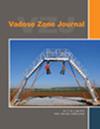不同种植制度下生物炭对土壤水分和植物吸收动态的影响
IF 2.8
3区 地球科学
Q3 ENVIRONMENTAL SCIENCES
引用次数: 0
摘要
近年来,生物炭改良剂在农业系统中的应用受到了广泛关注。在这项研究中,我们评估了灌溉新鲜市场番茄(Solanum lycopersicum)和雨养牧场(Poacee)种植系统施用生物炭对土壤水分和植物相互作用的5年影响。特别是,我们重点研究了三种当地生产的农业废料生物炭——杏仁壳、核桃壳和杏仁修剪残留物,这些生物炭使用移动热解装置进行热解。我们使用土壤水文模型HYDRUS‐1D,通过生物炭应用下保水、排水、蒸发和植物吸水的变化,明确跟踪季节和年度土壤水通量。建模结果表明,无论生物炭改良剂类型如何,施用5%的生物炭都能提高雨养系统顶部20厘米内的土壤水分有效性。这清楚地表明,在施用生物炭的情况下,植物吸水率更高,水分利用效率更高。相反,对灌溉系统进行类似的生物炭改良并没有影响WUE,而是减少了季节性土壤蒸发损失,从而减少了灌溉需求。在这两种种植系统中,降水量的逐年变化显著影响了生物炭施用下的节水总量,某些改良剂比其他改良剂保留了更多的水。考虑到无论种植制度如何,施用生物炭都能增加保水性,我们进一步使用了一种简单的方法来确定对照和生物炭处理之间的产量权衡(如果有的话)。我们的经济平衡清楚地表明,如果用碳信用来补偿,用生物炭改良土壤所节省的水并不能抵消产量差异,因此,应积极考虑生物炭的应用,因为它对潜在的温室气体缓解(例如,将果园废物从露天焚烧中转移)、节水和土壤健康具有直接和间接的好处。本文章由计算机程序翻译,如有差异,请以英文原文为准。
Impact of biochar amendments on soil water and plant uptake dynamics under different cropping systems
Application of biochar amendments in agricultural systems has received much attention in recent years. In this study, we assess the 5‐year impacts of biochar application on soil water and plant interactions for an irrigated fresh market tomato (Solanum lycopersicum) and a rainfed pasture (Poaceae) cropping system. In particular, we focus on three varieties of locally produced biochar from agricultural waste materials—almond shell, walnut shell, and almond pruning residues that are pyrolyzed using a mobile pyrolysis unit. We used the soil hydrological model HYDRUS‐1D to explicitly track seasonal and annual soil water fluxes through changes in water retention, drainage, evaporation, and plant water uptake under biochar application. Modeling results show that the application of biochar at 5% increased soil water availability within the top 20 cm for a rainfed system, irrespective of biochar amendment type. This is clearly indicative of higher plant water uptake and greater water use efficiency (WUE) under biochar application. In contrast, a similar biochar amendment for the irrigated system did not affect WUE, instead reducing seasonal soil evaporation loss and thereby reducing irrigation demand. In both cropping systems, year‐to‐year variability in precipitation significantly impacted the total amount of water saved under biochar application with certain amendments retaining more water than others. Given that biochar application increased water retention irrespective of cropping systems, we further used a simple approach to determine yield trade‐off, if any, between control and biochar treatments. Our economic balance clearly demonstrates that the water saved by amending soil with biochar does not offset the yield disparity if compensated with carbon credits and therefore, application of biochar should be actively considered for both its direct and indirect benefits to potential greenhouse gas mitigation (e.g., diverting orchard waste from open burning), water savings, and soil health.
求助全文
通过发布文献求助,成功后即可免费获取论文全文。
去求助
来源期刊

Vadose Zone Journal
环境科学-环境科学
CiteScore
5.60
自引率
7.10%
发文量
61
审稿时长
3.8 months
期刊介绍:
Vadose Zone Journal is a unique publication outlet for interdisciplinary research and assessment of the vadose zone, the portion of the Critical Zone that comprises the Earth’s critical living surface down to groundwater. It is a peer-reviewed, international journal publishing reviews, original research, and special sections across a wide range of disciplines. Vadose Zone Journal reports fundamental and applied research from disciplinary and multidisciplinary investigations, including assessment and policy analyses, of the mostly unsaturated zone between the soil surface and the groundwater table. The goal is to disseminate information to facilitate science-based decision-making and sustainable management of the vadose zone. Examples of topic areas suitable for VZJ are variably saturated fluid flow, heat and solute transport in granular and fractured media, flow processes in the capillary fringe at or near the water table, water table management, regional and global climate change impacts on the vadose zone, carbon sequestration, design and performance of waste disposal facilities, long-term stewardship of contaminated sites in the vadose zone, biogeochemical transformation processes, microbial processes in shallow and deep formations, bioremediation, and the fate and transport of radionuclides, inorganic and organic chemicals, colloids, viruses, and microorganisms. Articles in VZJ also address yet-to-be-resolved issues, such as how to quantify heterogeneity of subsurface processes and properties, and how to couple physical, chemical, and biological processes across a range of spatial scales from the molecular to the global.
 求助内容:
求助内容: 应助结果提醒方式:
应助结果提醒方式:


